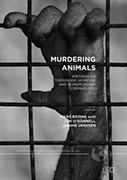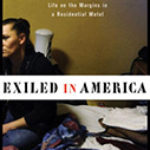Murdering Animals: Writings On Theriocide, Homicide, And Nonspeciesist Criminology

Author: Piers Beirne
Publisher: London: Palgrave Macmillan, 2018. 225p.
Reviewer: Shannon T. Grugan | January 2019
The mainstream paradigm of criminology and criminal justice, particularly in the United States, has long been centered on issues like violence — specifically, violence perpetrated against human victims — as well as drugs and street crime, and traditional property offenses like theft. However, in recent decades, some scholars have begun to take a more expansive look at the much larger reality of a world in which crime and other deviant behaviors occur in many other ways and in many different situations. One field that has opened because of this shifting paradigm is generally referred to as “Green Criminology”: this approach focuses on humanity’s impact on the natural world, particularly highlighting negative outcomes such as environmental harm and animal cruelty. Piers Beirne, the primary author of this volume, has been at the forefront of “green” criminological studies — specifically those focused on animals as victims of crime — for over two decades. Beirne was one of the first criminologists to call out criminology for its anthropocentrism and speciesism in focusing on human criminality and human crime victims. He and his two coauthors have written a very thought provoking and unique text on the historical, philosophical, and legal considerations that arise from the killing other animal species by humans, which they term “theriocide.”
Written in seven distinct though very much related chapters, this is not a typical criminology text full of applications of familiar theory or evidence. Although there is some discussion of criminology, Beirne and two chapter co-authors form the basis of their argument — that the killing of animals (“theriocide”) does constitute and should be viewed as the crime of murder — from varied frames of reference not typically seen in criminological analysis. For example, in addition to legal studies, the authors draw upon depictions of animals in art and art history, and they even cite a work of early 20th century Irish theater. The crux of their argument for the legitimacy of viewing theriocide as criminal behavior is their advocacy of the legal “personhood” of animals, in addition to criminological constructs such as embodying social constructionist views of human actions. However, the authors also draw conclusions and build on their arguments based on moral philosophies, allegories, “thought pieces” on the nature of violent crime, and even satirical presentations from artists and writers. Beirne acknowledges that each chapter was originally written as a stand-alone piece, but the three contributors thoughtfully weave these chapters together to support their central thesis.
Beirne begins the discussion on animal rights by recounting his time as a young man working in a pork slaughterhouse in the U.K. He notes that the rights of human beings are formally protected by law and/or global resolutions, and he explains how “personhood” is defined. He argues that “speciesism” — discrimination against nonhuman animals — is at play here. After discussing the concept of legal “personhood,” and offering justifications for extending personhood to animals, he then explains how extending personhood to animals could result in the view that the killing of animals constitutes the crime of “theriocide.” The chapter closes with a brief but important acknowledgement of the challenge of avoiding speciesism in word choice and nomenclature when describing the act of theriocide.
In chapter 2, Beirne asserts that animals have an intrinsic right to life that is (or should be) respected by humans. Beirne notes that humanity’s positions of power over other animal species have resulted in factory farming, climate change, hunting and the use of animals for sport, the wildlife trade, and other abuses that have resulted in theriocide and many other negative consequences for animals. Beirne asserts that in most cases humanity has attempted to soften the blow or mask the realities of animal suffering by using euphemisms for this abuse and adopting an “out of sight, out of mind” mentality. For example, terms like “culling,” or “humane euthanasia” sound much more palatable than the killing of wild animals due to overpopulation or the killing of domesticated animals because they fail to be adopted while in “shelters.” When people eat meat or other animal products, they rarely think of the abuse and killing of the animals from whom these products are made because they are so far removed from the chicken houses, the concentrated animal feeding operations and the slaughterhouses. When one stops using veiled language and euphemisms, Beirne argues that viewing theriocide as murder becomes clearer, more salient and more urgent.
The next four chapters address the depictions of violence against animals in artistic and humanities-based media. In chapter 3, Beirne and Janine Janssen provide an in-depth case study of the painting Life of a Hunter (alternatively titled Punishment of a Hunter) by the 17th century Dutch artist Paulus Potter. This 14-panel painting depicts a human hunter and his hunting dogs going after many different animals, including bulls, deer, boars and lions. However, the tables then turn, and the hunter is captured by the animals upon which he had formerly preyed and is put on a sort of trial by the animals. He is then killed on a pyre or spit by the animals for his crimes against them. Beirne and Janssen argue that Potter could either have been either advocating for animal rights or presenting an allegory for the political climate of the time in the Dutch Republic; or, alternatively, he may have been satirizing the legal trials of animals that allegedly occurred went on in that era.
These trials are also the subject of chapter 4, in which Beirne presents the history of “justiciable animals”: i.e., animals that were prosecuted and sentenced in courts of law. This primarily occurred in Europe beginning in the Middle Ages. He reviews the concept of “murdering animals” — primarily as seen in judicial decisions based on crimes these animals had committed — and also shows how animals have been viewed and defined in various legal systems, specifically as to their culpability for crimes they may have perpetrated against humans. Several cases are discussed involving animals who had committed violent acts or been involved in other unacceptable acts — like bestiality or even “sorcery” — all of which resulted in the killing of these animals after legal proceedings. (Some of this material is based on a painstaking search of historical records, while another key source is a catalog collected in the 1906 book The Criminal Prosecution and Capital Punishment of Animals (CPCPA) by E.P. Evans. Beirne draws interesting parallels between some of these historical practices and contemporary behaviors that are commonplace, including the euthanasia of healthy animals in overcrowded shelters or the killing of aggressive animals by animal control officers. He argues that these executions of old, which may seem odd or peculiar today, are still occurring today, just under a different guise.
Chapter 5 discusses the work of William Hogarth, a British artist in the 17th century, who regularly depicted animals in his paintings. Many of Hogarth’s works involved use of animals as items of propaganda to show the political and social prowess of his human subjects. His portraiture work regularly included the subjects’ pets (usually dogs) as a sign of status and patriotism. Other such Hogarth works included depictions of cattle and other animals used for food, and the final meats and other food products that were harvested from these animals. Beirne asserts that beef was viewed as a symbol of Great Britain’s power, strength and patriotism in that era. He further argues that Hogarth accomplished two conflicting outcomes: his works promoted an increase in beef consumption, but also may have resulted in an outcry against animal cruelty.
In chapter 6, Beirne and co-author Ian O’Donnell examine the crime of murder and the societal reaction to this crime through an analysis of Playboy of the Western World, an early 20th century play by John Millington Synge. The story revolves around a man’s two attempts to kill his father (quite unsuccessfully), and the reaction of some local townspeople in a pub to those attempts. Beirne and O’Donnell describe the real-life controversy that this play caused: at its debut in 1907 riots occurred outside the theater because of the depictions of Irish people in the play. At first take, this chapter may seem out of step with the rest of this book, due to its lack of any mention of animals whatsoever. However, the authors’ focus here is on murder as an act and as a cultural phenomenon, and how society views it as sometimes acceptable and sometimes unacceptable. While there is no discussion of animals in the chapter, the authors are making a larger argument about how social construction is incorporated into definitions of the illegal and/or unacceptable taking of another creature’s life.
In the concluding chapter, Beirne builds upon the preceding discussions to make final statements about theriocide, the rights of animals and humanity’s ability to move beyond speciesism so that theriocide may be regarded as a form of murder in the future. He rightfully criticizes mainstream criminology for being slow to study animal abuse and cruelty, but also recognizes that this may be a product of wider social views of animals. As evidence to suggest that there is a shift occurring to a new consensus — that the act of killing animals is unacceptable — Beirne cites changes or proposed changes in the terminology of animal crimes, as well as proposals to create new legal policies or even new crimes. For example, “bestiality” is now recognized as animal sexual assault, and researchers studying the trade in illegal wildlife and animal products are inclined to use the terms “abduction” or “kidnapping” instead of “trafficking.” Beirne also identifies recent attempts to have the United Nations recognize the crime of “ecocide,” which is the destruction of ecosystems and their inhabitants, as further evidence of society’s changing views about harmful human activities against animals.
The central argument that brings this book together is that animals have a right to live their lives free from humanity’s needs, wants or presumed supremacy over them. When humans take the life of animals — whether through factory farming, climate change or other environmental problems, animal cruelty and neglect, or other human actions— it should be viewed and treated in the same way as the killing of a human being. Beirne and his colleagues support this statement in a captivating and unique interdisciplinary look at humanity’s views of animals and the crime of murder in various art forms and other media. This book is suitable for criminologists and for scholars who study legal issues and animals, as well as animal rights activists, humanities’ scholars and artists who have depicted injustices toward animals.


